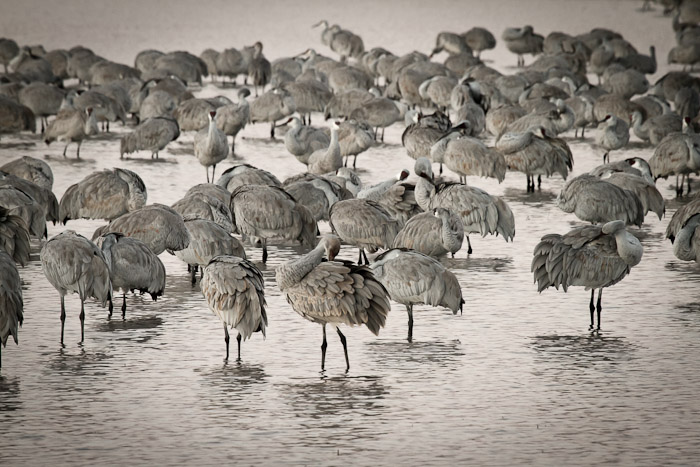Monday, January 17, 2011 - Bosque Birdwatchers RV Park, San Antonio NM
< previous day | archives | next day >

First Light, Sandhill Cranes, Bosque del Apache National Wildlife Refuge, San Antonio NM, January 17, 2011
Now I've done it
Happy to be back and anxious to see what the cranes have been up to I set off before first light to the first pond. In the past I would usually walk down - it's only a mile or so - but today I drove down and ended up spending half the day there.
In my excitement to be back I took way way too many pictures and then spent the rest of the morning trying to deal with them all. Good grief what a burden I am to myself. Dealing with all these potential riches is a bit like mining for diamonds, sorting through tons of detritus looking for the occasional gem. But that's not quite the right analogy.
Unlike the diamond miner who has no use for the lesser stuff, I'm afraid to throw out anything that might be useful some day.
By chance, Sam Smith posted today on his UNDERNEWS blog an extract of an interview in which Malcolm Gladwell casts a light on this lifelong problem of mine of having trouble getting rid of anything I think might have value to me someday.
I have always assumed this tendency came from my heritage growing up with parents and grandparents who went through the depression with very limited resources. In their case anything that might prove useful in future had very real value and they passed on that cast of mind. But there might be more to it than that - there might be an additional contribution from my creative mind. I need to ponder this.
Question: What advice do you have for aspiring writers?
Malcolm Gladwell: This I think is true, not just of writers, but of anyone who is in a creative space, that you have to reverse the normal human tendency, which is to edit. So a lot of... and occasionally this is, I think, a source of a great deal of frustration that exists between people in creative and non-creative universes, which is that creative people I think are trying to... their lives and their brains, their brains are messy. Their imaginations are messy. Why, because they don’t want to throw anything out. Why don’t they want to throw anything out? Because they believe on some level that there is always something of interest or value in whatever they encounter[emphasis mine]. They know enough about how mysterious and serendipitous and unpredictable the creative process is that they realize that it’s dangerous to kind of make too hasty a judgment about the value of anything that they come across.
People in non-creative universes have exactly the opposite relationship to information—or to experiences is a better way of putting it. They’ll see something and they’ll say "Is it relevant to what I'm doing?" And if it’s not they should push it aside and focus on what they’re kind of task is. If you're at Proctor & Gamble and you’re the head of Ivory soap you’re job is to sell more soap and if you get distracted by some interesting, but ultimately marginal subsidiary issue you won’t sell as much soap. And that is an extreme example, but that's a world that demands focus. If you’re a surgeon and you’re operating you cannot let your imagination wander about some idiosyncrasy of the operation. You have to kind of zero in. So I think that is a kind of... That embracing of messiness and understanding its contribution to the creative process is something that writers and creative types, artists, whatever have got to cultivate, have to learn to be comfortable with. Because it goes against a lot of our kind of instincts and training as kind of educated people.
From an interview with Max Miller recorded December 16, 2010 [source link]
clipped January 17, 2011
Collection(s): Philosophy
Night camp
Site 10 - Bosque Bird Watcher's RV Park, San Antonio NM
- This is a basic, small Mom & Pop RV Park with full hookups.
- Verizon cell phone and Broadband service are available here with a strong signal.
- Locate Bosque Bird Watcher's RV Park on my Night Camps map
- Click for Google street view
- Check the weather in San Antonio NM
Running With the Pack
Hardly anyone out there is going to take this seriously, but TV changes you. The kicker is that if you watch it all the time, you'll never know, which under normal circumstances ought to scare you shitless...
No amount of sermonizing will make a difference here, so I'll move on. But I'm telling you, it's true. If you disconnect from the medium long enough to stop associating certain days and times with TV shows you're used to watching, you WILL be different, with values and behavior that arise from sources you never knew existed. There is no arguing with this, you simply have to experience it.